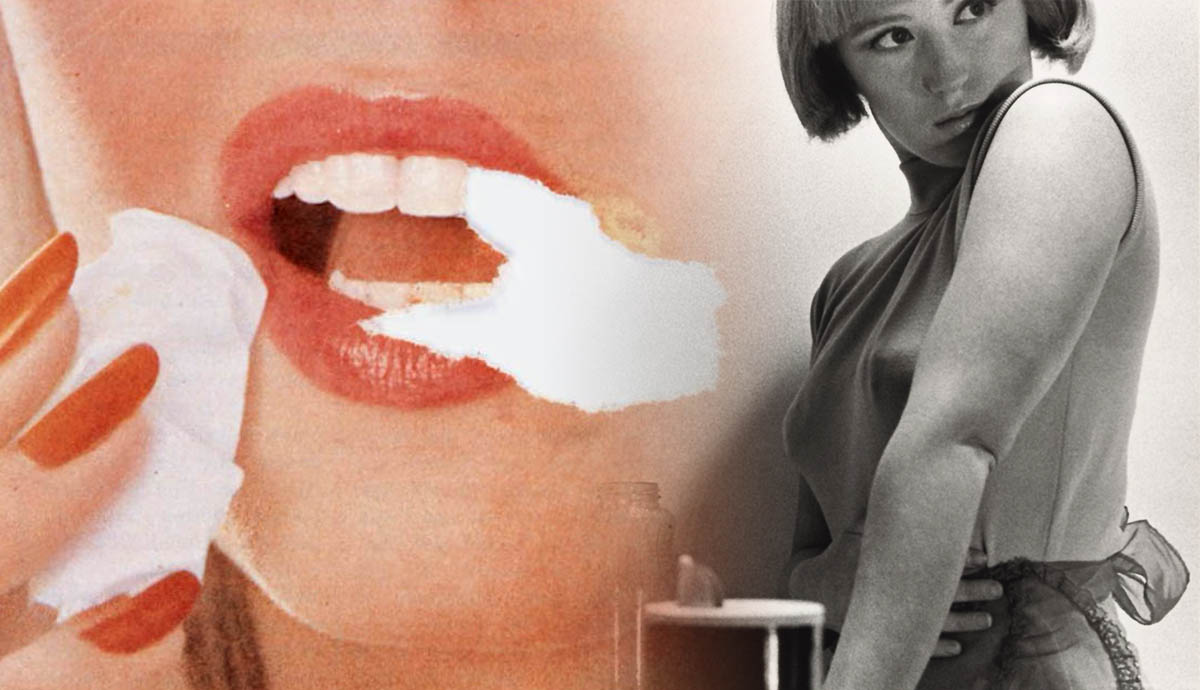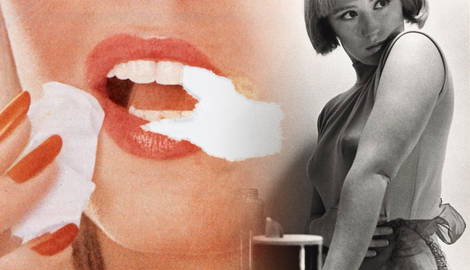
During the 1970s, women art historians such as Linda Nochlin organized feminist exhibitions like the 1976 Women Artists 1550-1950 in LACMA. This type of exhibition showed the existing lack of knowledge about female artists in art history and their exclusion from the majority of museum collections. During this time, feminist art theory started to develop as a practice. Feminist artists used different strategies in their work to raise questions about the political, social, and cultural position of women in society. When we look at the art of Cindy Sherman, Barbara Kruger, or Judy Chicago, there isn’t a particular style but a diverse artistic approach. Here are 7 important feminist artworks you should know!
1. The Feminist Art Of Cindy Sherman: 69 Untitled Film Stills

Cindy Sherman is a famous American artist born in 1954. Most of her work consists of portraits in which she usually embodies a character. Her widely praised series called Untitled Film Stills consists of black and white photographs done in the late seventies. In this series, Sherman poses as fictional characters from the 1950s and ’60s films. Many photos from the series look like stills taken from movie scenes when something unpleasant or scary is about to happen.
To understand Cindy Sherman’s series, and feminist art in general, we need to look at Laura Mulvey‘s seminal essay on the male gaze. In her 1975 essay Visual Pleasure and Narrative Cinema, Mulvey analyzed how the camera looks at women in Hollywood cinema. She categorized it as something called the male gaze – a gaze that objectifies women. Through the male gaze, female characters are fetishized and portrayed as passive.

Therefore, Cindy Sherman plays the stereotypical female characters Hollywood wants us to see. The artist shows the 1950’s Hollywood femininity as a masquerade. When creating her feminist art, Sherman uses make-up, wigs, props, poses, and facial expressions to show that what we see on the silver screen is a construct. Even though Sherman uses herself as a model, the photographs are not necessarily understood as self-portraits since the artist poses as an imagined character.
2. Guerilla Girls: Do Women Have To Be Naked To Get Into the Met. Museum?

The Guerilla Girls describe themselves as feminist activist artists. The group consists of many anonymous members. The feminist artworks of Guerilla Girls resemble posters and billboards through which they communicate important political messages. Through the simple but effective look of texts and slogans, Guerilla Girls aim to show how women are discriminated against in the art world. They not only talk about the lack of represented women artists, but also the lack of represented artists of color.
In their 1989 piece Do Women Have To Be Naked To Get Into the Met. Museum? Guerilla Girls pointed at the huge differences in the number of women artists featured in The Met Museum and the number of female nudes in the paintings you can see there. The work shows an altered version of the painting La Grande Odalisque by the French neoclassical painter Jean-August-Dominique Ingres. Instead of Odalisque’s head, we see a Gorilla mask. The piece was initially created for the New York City Public Art Fund, but they later rejected it. So, for the work to be seen by a large number of people, Guerilla Girls rented advertising spaces on the New York City buses. Their feminist artworks are supposed to raise awareness of the existing gender disparity in different creative industries.
3. Barbara Kruger: Untitled (It’s A Small World But Not If You Have To Clean It)

Barbara Kruger is another artist who uses slogans in her feminist art pieces. Influenced by the consumer culture and mass media Kruger decodes messages we constantly receive through different outlets. Through her image-texts Kruger asks the questions of who creates codes of behavior, oppression, culture, and identity.
Some of her slogans sound like commands. They almost evoke a feeling of someone powerful telling us how we should or should not behave. Kruger has said that she believes pictures and words that “have the power to tell us who we are and who we aren’t, who we can be and who we can never be”.
In her art, Kruger points to patriarchal language and images. Her explicitly feminist pieces like Your body is a battleground or Your gaze hits the side of my face show women taking over rights to their bodies.
In her piece It’s a small world but not if you have to clean it, Kruger addresses the suburban lifestyle of postwar America. The famous feminist Betty Friedan wrote about the issues of American housewives and “the problem that has no name” in her book The Feminine Mystique. Women doing the majority of housework is still an issue, so Kruger’s piece is relevant when looking at contemporary society, not just the past.
4. Judy Chicago’s Seminal Feminist Artwork: The Dinner Party

Judy Chicago‘s installation The Dinner Party is one of the most famous pieces of feminist art. This art installation consists of a table filled with ceramics, textiles, and china that commemorate famous women throughout history. Set as a triangle, the table has 39 plates each of them representing a particular woman. Some of the women “seated at the table” are Georgia O’Keeffe, Virginia Woolf, Emily Dickinson, Elizabeth I, Theodora, and Sappho. The plates are also supposed to resemble female genitalia. Another 999 names of women are written in gold on the marble floor beneath the table.
It took four years to create the piece in all its fine details. The installation caused quite a stir when it first opened at the San Francisco Museum of Modern Art in 1979 and 100,000 people came to see it.
Chicago’s piece also shows embroidery and other art practices that have historically been categorized as feminine and therefore of less value than painting and sculpture.
The Dinner Party is a powerful and massive art piece that honors and celebrates women, their sexuality, and their historical importance. This art installation is permanently exhibited at the Brooklyn Museum, so if you’re traveling to New York City don’t miss the chance to see it.
5. Mary Beth Edelson’s Collage: Some Living American Women Artists/Last Supper

Another iconic work of feminist art is Mary Beth Edelson‘s Some Living American Women Artists/Last Supper. In her version of Leonardo da Vinci’s Last Supper Edelson changed the faces of Jesus Christ and the apostles with faces of female artists. Instead of the face of Christ, we see the face of Georgia O’Keeffe. Other than O’Keeffe, Edelson also included artists like Agnes Martin, Helen Frankenthaler, Lee Krasner, Alma Thomas, and Yoko Ono. Beneath the black and white pictures of every figure, Edelson wrote the name of the person we see. Like Judy Chicago in her piece The Dinner Party, Edelson is the one giving women their deserving “seat at the table.” There are even more photographs of women artists around the main image, each numbered and named respectively.
Edelson also used other paintings from art history like Ingre’s The Turkish Bath and Rembrandt’s famous work The Anatomy Lesson of Dr. Nicolaes Tulp for her artistic interventions. Feminist viewpoints are present even in the titles of her artworks. For example, her version of Rembrandt’s group portrait is called Death of Patriarchy / A.I.R. Anatomy Lesson. By appropriating famous artworks like The Last Supper, Edelson questions the position of women in both art history and the church.
6. Martha Rosler’s Video: Semiotics Of The Kitchen

Martha Rosler is an American artist who works in different artistic mediums like photomontage, installation, video, performance, sculpture, and digital art. The main themes of her work are war and gender.
Her famous piece, Semiotics of the Kitchen, is a 6-minute long video-performance that satirizes cooking shows. The piece looks at how television represents gender.
In the video, Rosler puts on an apron imitating a housewife, and lists different kitchen utensils, reciting them from A to Z. While naming the objects, Rosler performs for the camera theatrically and aggressively. The artist makes a parody out of “the kitchen” which is typically seen as a female space in the house. Rosler, therefore, uses parody as a strategy to deconstruct the idea of gendered space. The work also functions as a reference to Julia Child, a television personality famous for her cooking show The French Chef. Instead of a cheery and joyful Child, Rosler performs as serious and angry.
Rosler also addresses issues of gender roles, domestic spaces, and politics in her famous photomontages in the series House Beautiful (Bringing the Work Home).
7. Yugoslav Feminist Art In Sanja Iveković’s Paper Women

Sanja Iveković is a Croatian artist born in 1949. Iveković was a part of a group of young Yugoslav artists called the New Art Practice that emerged after the student’s protest of 1968. In her work, Iveković often addresses feminist issues, gender differences, and problems of representation of women in the media.
In her 1976-77 series named Paper Women, Iveković used magazine advertisements featuring different beautiful women. In Iveković’s version of the ads, women are shown as torn apart, cut, and scratched over their skin. The artist shows beauty as a troubling concept where pain and aggression lie within.
You can also notice her feminist viewpoints in works like Sweet Violence or Diary. In Diary images of women in full make-up are shown on one side, while used tissue paper and cotton pads are positioned on the left. The dirty disposable objects on the right show that beauty standards are something that is constructed by using certain products.
Like many other feminist artists, Iveković shows that stereotypical standards of female beauty can also feel confining and aggressive. For Iveković, the media is ultimately violent towards women, and she acknowledges that pain and violence through her interventions on the original magazine images.










